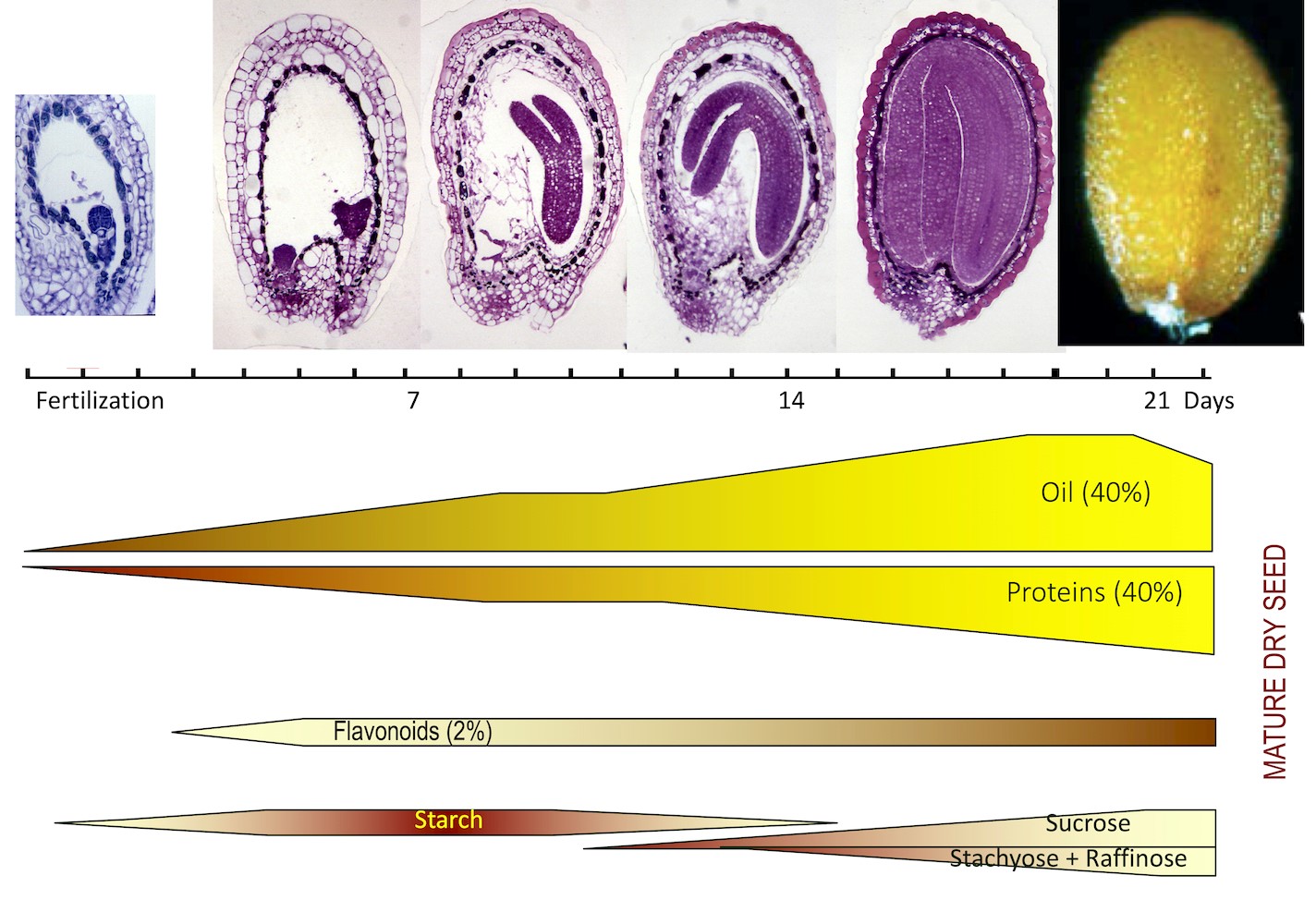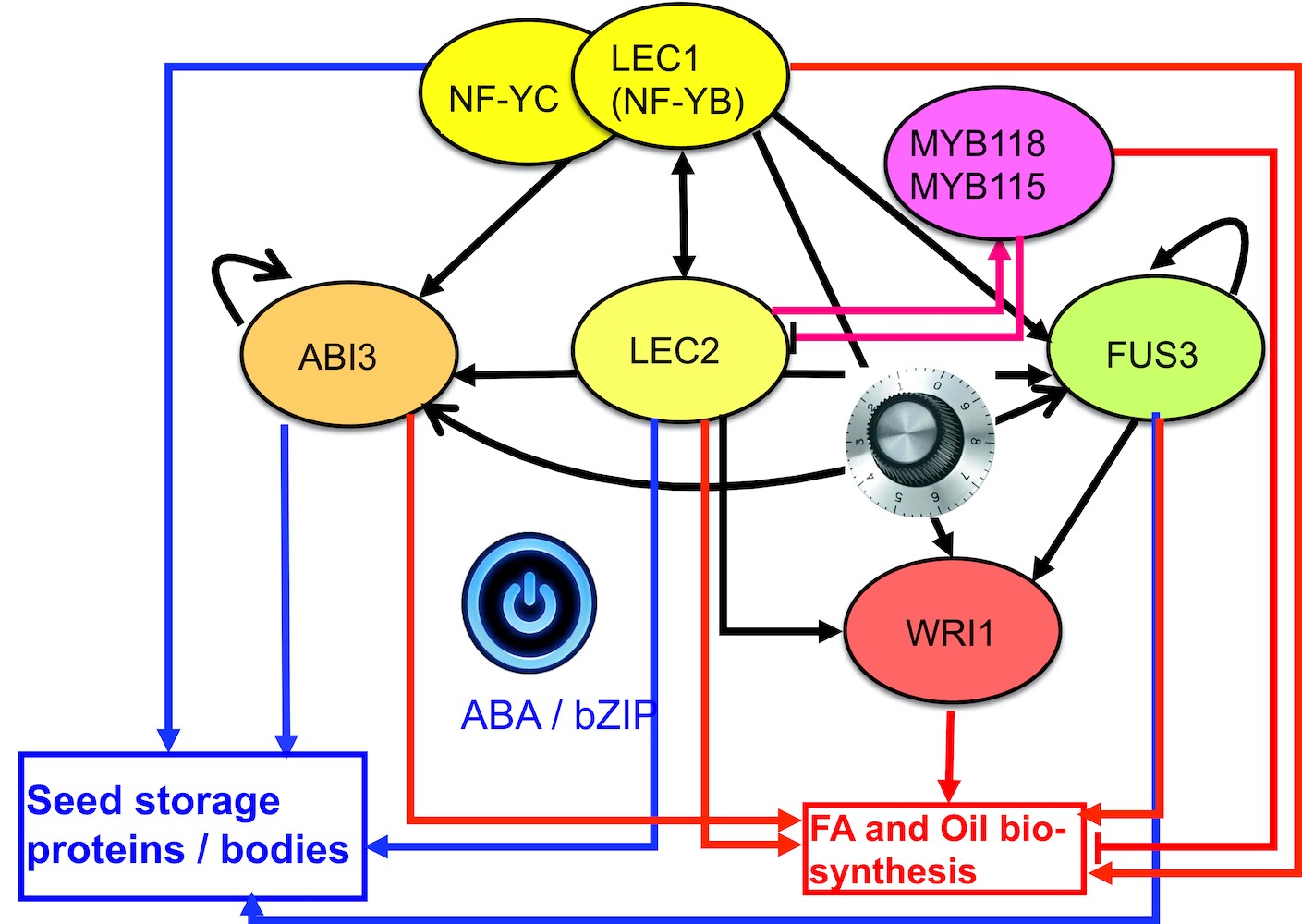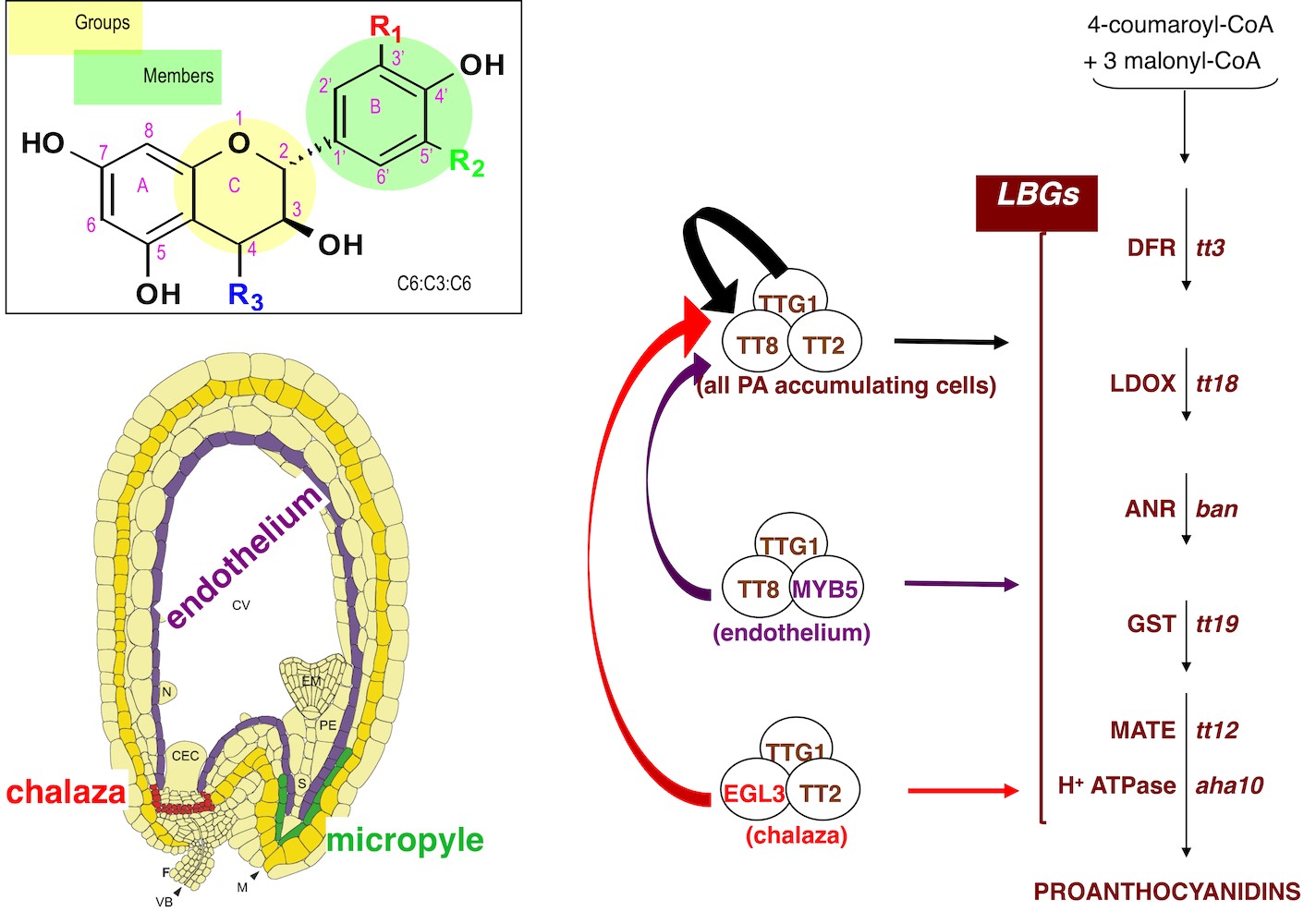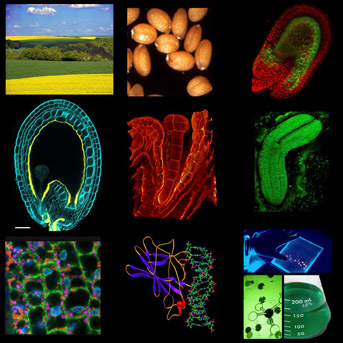Seeds play fundamental roles in plant life and evolution, and for crop improvement. They also provide a large share of animal and human food and renewable raw materials for different industries.
Seed development involves precise regulations of the growth of different tissues (i.e. embryo, endosperm, and seed coat) and metabolic pathways allowing the accumulation of storage compounds (e.g. oil, sugars or proteins) and specialized protective metabolites (e.g. phenolics). We are mainly working on two gene networks (LAFL and TT) involved in these regulations, using molecular, genetic, cytological, biochemical and multi-omic approaches with Arabidopsis or crop species.
Biological Question
Seed development requires the coordinated growth of genetically different seed tissues (i.e. embryo, endosperm and seed coat) and the implementation of different primary and specialized metabolic pathways.

The metabolic routes of the main storage compounds are rather well characterized. Nevertheless, the developmental or environmental regulations and partitioning between the different tissues and metabolic pathways remain to be elucidated. Our scientific objectives are to 1) characterize the metabolic landscape of seeds from different plant species, 2) to identify the genes that control seed development and primary or specialized metabolisms (e.g. fatty acids and phenylpronanoids) and 3) to elucidate the molecular and cellular mechanisms involved and integrate them in comprehensive gene regulatory networks and seed models.
Models, tools and methods
Our current projects mainly focus on two regulatory networks namely the “LAFL” and “TT” and their metabolic or developmental target genes. The LAFL proteins (LEC1-ABI3-FUS3-LEC2), with some of their targets (e.g. WRI1 and different MYBs) control zygotic development and maturation in relation with the accumulation of the main storage compounds (oil and proteins), as well as somatic embryogenesis.

The regulatory TRANSPARENT TESTA (TT) genes, which encode MYB-bHLH-WDR (MBW) protein complexes, MADS, Zn-Finger or WRKY proteins, control the differentiation of maternal tissues and/or flavonoid biosynthesis.

Although tremendous progresses have been obtained during the last years with crops species, A. thaliana remains a reference species for studying seed biology and molecular genetic approaches, and for elaborating a comprehensive scheme of seed development and maturation. Moreover, LAFL and TT regulatory networks are surprisingly well conserved among angiosperms, thus facilitating translational biology. Hence, most of our work is carried out with Arabidopsis and we have developed several collaborations on various crop species such as maize, wheat, sunflower, rapeseed, grape, apple, and strawberry. Moreover, we also work with Camelina sativa, a rustic Brassicacea crops of interest, related to rapeseed and Arabidopsis, and relatively easy to transform. We are using various tools encompassing genetics, molecular biology, cytological, biochemical and multi-omic approaches (genomic, transcriptomic, metabolomic and bioinformatic).
Our current projects mainly focus on two regulatory networks namely the “LAFL” and “TT” and their metabolic or developmental target genes. The LAFL proteins (LEC1-ABI3-FUS3-LEC2), with some of their targets (e.g. WRI1 and different MYBs) control zygotic development and maturation in relation with the accumulation of the main storage compounds (oil and proteins), as well as somatic embryogenesis.

The regulatory TRANSPARENT TESTA (TT) genes, which encode MYB-bHLH-WDR (MBW) protein complexes, MADS, Zn-Finger or WRKY proteins, control the differentiation of maternal tissues and/or flavonoid biosynthesis.

Although tremendous progresses have been obtained during the last years with crops species, A. thaliana remains a reference species for studying seed biology and molecular genetic approaches, and for elaborating a comprehensive scheme of seed development and maturation. Moreover, LAFL and TT regulatory networks are surprisingly well conserved among angiosperms, thus facilitating translational biology. Hence, most of our work is carried out with Arabidopsis and we have developed several collaborations on various crop species such as maize, wheat, sunflower, rapeseed, grape, apple, and strawberry. Moreover, we also work with Camelina sativa, a rustic Brassicacea crops of interest, related to rapeseed and Arabidopsis, and relatively easy to transform. We are using various tools encompassing genetics, molecular biology, cytological, biochemical and multi-omic approaches (genomic, transcriptomic, metabolomic and bioinformatic).
Societal and economical impacts
Seeds play a critical role in plant life cycle and for humankind. Seeds allow most of the higher plants to cope with unfavourable environmental conditions by interrupting their life cycle and resuming growth when placed under favourable conditions. Hence, they play a key role in the dispersion and evolution of higher plants on Earth. Moreover, seeds are, directly or indirectly, the main source for animal and human nutrition. They constitute the main vector for the improvement of agronomic practices and the management of genetic resources, two key factors for the development of sustainable agriculture and preservation of biodiversity. Last, seed storage compounds constitute a sustainable alternative to fossil carbon for chemical industry and can accumulate various high added-value “specialized” metabolites, with expanding applications for agriculture/bio-control, environment, chemistry, or animal and human nutrition and health.
Seeds play a critical role in plant life cycle and for humankind. Seeds allow most of the higher plants to cope with unfavourable environmental conditions by interrupting their life cycle and resuming growth when placed under favourable conditions. Hence, they play a key role in the dispersion and evolution of higher plants on Earth. Moreover, seeds are, directly or indirectly, the main source for animal and human nutrition. They constitute the main vector for the improvement of agronomic practices and the management of genetic resources, two key factors for the development of sustainable agriculture and preservation of biodiversity. Last, seed storage compounds constitute a sustainable alternative to fossil carbon for chemical industry and can accumulate various high added-value “specialized” metabolites, with expanding applications for agriculture/bio-control, environment, chemistry, or animal and human nutrition and health.
From evolutionary, physiological, agronomical, nutritional or industrial points of view, seed “quality" and potential uses are determined by the structure and quantity of the various macromolecules stored in the different seed tissues, namely maternal tissues (integuments, nucellus and chalaza), the endosperm and the embryo. For developing more sustainable productions and uses, it would be useful to better understand and adapt seed structure and/or composition to fit agronomic, nutritional or industrial needs. Understanding the genetic and molecular mechanisms that control seed development and maturation can provide new molecular tools for improving the quality of seeds by classical or new breeding technologies. Last, a more quantitative view of these processes will help to develop a more predictive biology and thus, an efficient engineering of seed quality.

Leader:
Loïc Lepiniec